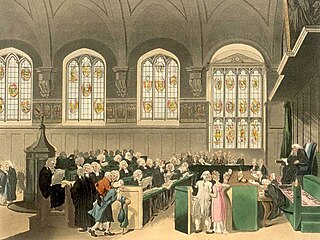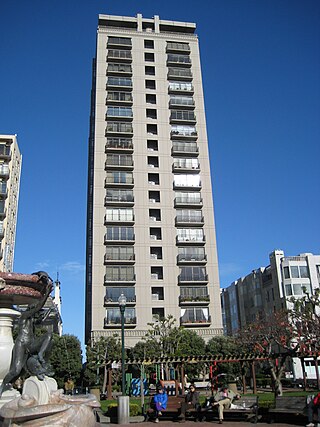Related Research Articles
Escheat is a common law doctrine that transfers the real property of a person who has died without heirs to the crown or state. It serves to ensure that property is not left in "limbo" without recognized ownership. It originally applied to a number of situations where a legal interest in land was destroyed by operation of law, so that the ownership of the land reverted to the immediately superior feudal lord.

Estoppel is a judicial device in common law legal systems whereby a court may prevent or "estop" a person from making assertions or from going back on his or her word; the person being sanctioned is "estopped". Estoppel may prevent someone from bringing a particular claim. Legal doctrines of estoppel are based in both common law and equity. It is also a concept in international law.
In common law and statutory law, a life estate is the ownership of immovable property for the duration of a person's life. In legal terms, it is an estate in real property that ends at death, when the property rights may revert to the original owner or to another person. The owner of a life estate is called a "life tenant". The person who will take over the rights upon death is said to have a "remainder" interest and is known as a "remainderman".
A deed, commonly, is a legal document that is signed and delivered, especially one regarding the ownership of property or legal rights. More specifically, in common law, a deed is any legal instrument in writing which passes, affirms or confirms an interest, right, or property and that is signed, attested, delivered, and in some jurisdictions, sealed. It is commonly associated with transferring (conveyancing) title to property. The deed has a greater presumption of validity and is less rebuttable than an instrument signed by the party to the deed. A deed can be unilateral or bilateral. Deeds include conveyances, commissions, licenses, patents, diplomas, and conditionally powers of attorney if executed as deeds. The deed is the modern descendant of the medieval charter, and delivery is thought to symbolically replace the ancient ceremony of livery of seisin.
Adverse possession, sometimes colloquially described as "squatter's rights", is a legal principle in the Anglo-American common law under which a person who does not have legal title to a piece of property—usually land —may acquire legal ownership based on continuous possession or occupation of the property without the permission (licence) of its legal owner.

Lord of the manor is a title that, in Anglo-Saxon England and Norman England, referred to the landholder of a rural estate. The titles date to the English feudal system. The lord enjoyed manorial rights as well as seignory, the right to grant or draw benefit from the estate. The title continues in modern England and Wales as a legally recognised form of property that can be held independently of its historical rights. It may belong entirely to one person or be a moiety shared with other people.

A fixture, as a legal concept, means any physical property that is permanently attached (fixed) to real property. Property not affixed to real property is considered chattel property. Fixtures are treated as a part of real property, particularly in the case of a security interest. A classic example of a fixture is a building, which, in the absence of language to the contrary in a contract of sale, is considered part of the land itself and not a separate piece of property. Generally speaking, the test for deciding whether an article is a fixture or a chattel turns on the purpose of attachment. If the purpose was to enhance the land, the article is likely a fixture; if the article was affixed to enhance the use of the chattel itself, the article is likely a chattel.

Lost, mislaid, and abandoned property are categories of the common law of property which deals with personal property or chattel which has left the possession of its rightful owner without having directly entered the possession of another person. Property can be considered lost, mislaid, or abandoned depending on the circumstances under which it is found by the next party who obtains its possession.
Dilapidation is a term meaning a destructive event to a building, but more particularly used in the plural in English law for
- the waste committed by the incumbent of an ecclesiastical living
- the disrepair for which a tenant is usually liable when he has agreed to give up his premises in good repair.

Bruton v London and Quadrant Housing Trust[1999] UKHL 26 is an English land law case that examined the rights of a 'tenant' in a situation where the 'landlord', a charitable housing association had no authority to grant a tenancy, but in which the 'tenant' sought to enforce the duty to repair on the association implied under landlord and tenant statutes. The effect of the case is to create the relationship of de facto landlord and tenant between the parties.
The history of English land law can be traced back to Roman times. Throughout the Early Middle Ages, where England came under rule of post-Roman chieftains and Saxon monarchs, land was the dominant source of personal wealth. English land law transformed further from the Saxon days, particularly during the post-Norman Invasion feudal encastellation and the Industrial Revolution. As the political power of the landed aristocracy diminished and modern legislation increasingly made land a social form of wealth, subject to extensive social regulation such as for housing, national parks, and agriculture.

Smith and Snipes Hall Farm Ltd v River Douglas Catchment Board [1949] 2 KB 500 is an English land law and English contract law appeal decision. The case, decided by Denning LJ, confirmed positive covenants can supplant privity of contract in contracts to improve land and secondly a covenant should be implied where the contract shows an intention that the obligation would attach to the land. The case thirdly held in that context, a somewhat uncertain description of lands which was capable of being rendered certain by extrinsic evidence was sufficient to enforce the covenant.

Landlord–tenant law is the field of law that deals with the rights and duties of landlords and tenants.

Tulk v Moxhay is a landmark English land law case that decided that in certain cases a restrictive covenant can "run with the land" in equity. It is the reason Leicester Square exists today.

Errington v Wood[1951] EWCA Civ 2 is an English contract law and English land law judicial decision of the Court of Appeal concerning agreement and the right to specific performance of an assurance that is relied on.

English land law is the law of real property in England and Wales. Because of its heavy historical and social significance, land is usually seen as the most important part of English property law. Ownership of land has its roots in the feudal system established by William the Conqueror after 1066, and with a gradually diminishing aristocratic presence, now sees a large number of owners playing in an active market for real estate. The modern law's sources derive from the old courts of common law and equity, along with legislation such as the Law of Property Act 1925, the Settled Land Act 1925, the Land Charges Act 1972, the Trusts of Land and Appointment of Trustees Act 1996 and the Land Registration Act 2002. At its core, English land law involves the acquisition, content and priority of rights and obligations among people with interests in land. Having a property right in land, as opposed to a contractual or some other personal right, matters because it creates privileges over other people's claims, particularly if the land is sold on, the possessor goes insolvent, or when claiming various remedies, like specific performance, in court.
Compulsory purchase is the power to purchase rights over an estate in English land law, or to buy that estate outright, without the current owner's consent. In England and Wales, Parliament has granted several different kinds of compulsory purchase power, which are exercisable by various bodies in various situations. Such powers are meant to be used "for the public benefit". This expression is interpreted broadly.
The South African law of lease is an area of the legal system in South Africa which describes the rules applicable to a contract of lease. This is broadly defined as a synallagmatic contract between two parties, the lessor and the lessee, in terms of which one, the lessor, binds himself to give the other, the lessee, the temporary use and enjoyment of a thing, in whole or in part, or of his services or those of another person; the lessee, meanwhile, binds himself to pay a sum of money as compensation, or rent, for that use and enjoyment. The law of lease is often discussed as a counterpart to the law of sale.

In English common law, real property, real estate, immovable property or, solely in the US and Canada, realty, refers to parcels of land and any associated structures which are the property of a person. In order for a structure to be considered part of the real property, it must be integrated with or affixed to the land. Examples include crops, buildings, machinery, wells, dams, ponds, mines, canals, and roads. The term is historic, arising from the now-discontinued form of action, which distinguished between real property disputes and personal property disputes. Personal property, or personalty, was, and continues to be, all property that is not real property.

Accession is a method of original acquisition of property under Scots property law. It operates to allow property to merge with another object, either moveable or heritable. Accession derives from the Roman-law concept of the same name. Other jurisdictions employ similar rules. The leading case in this area is said to be Brand's Trustees v Brand's Trustees (1876) 3 R (HL) 16.
References
- Hepburn. Principles of Property Law. Second Edition. 2001. p 148.
- Brantly. Principles of the Law of Personal Property. 1891. Paras 9 and 151.
- Indermaur. Principles of the Common Law. Fourth Edition. 1885. p 63.